Pioneer PDP-433MXE Manual
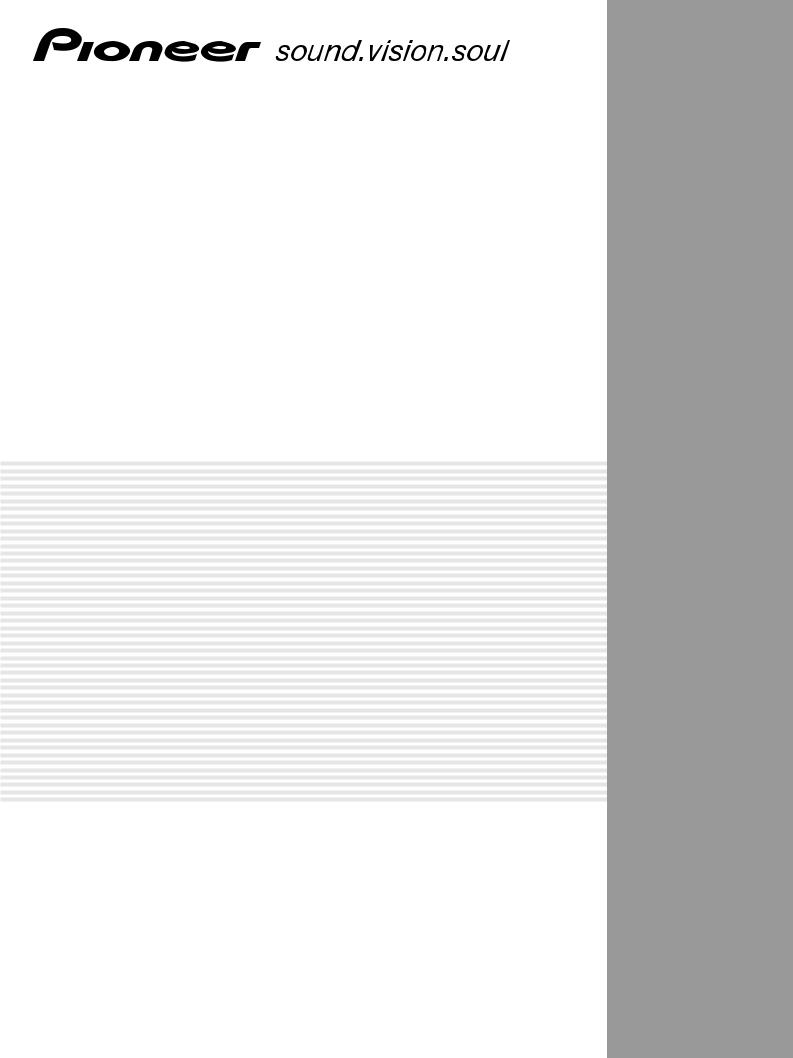
Plasma Display Écran à plasma Plasma-Display
PDP-503MXE PDP-433MXE
Operating Instructions Mode d’emploi Bedienungsanleitung

English
This unit has been designed for use as a computer display monitor. The optional video card is required if you wish to view other video signals on the monitor. For details consult your local retail dealer.
Français
Cet appareil est conçu pour une utilisation comme moniteur d’affichage d’ordinateur.
La carte vidéo optionnelle est nécessaire si vous souhaitez regarder d’autres signaux sur ce moniteur. Pour plus de renseignements, consultez votre revendeur.
Deutsch
Dieses Gerät ist als Monitor für Personalcomputer konzipiert.
Wenn andere Videosignale auf diesem Monitor betrachtet werden sollen, muss die optionale Videokarte installiert werden. Weitere Einzelheiten hierzu erfahren Sie von Ihrem Fachhändler.
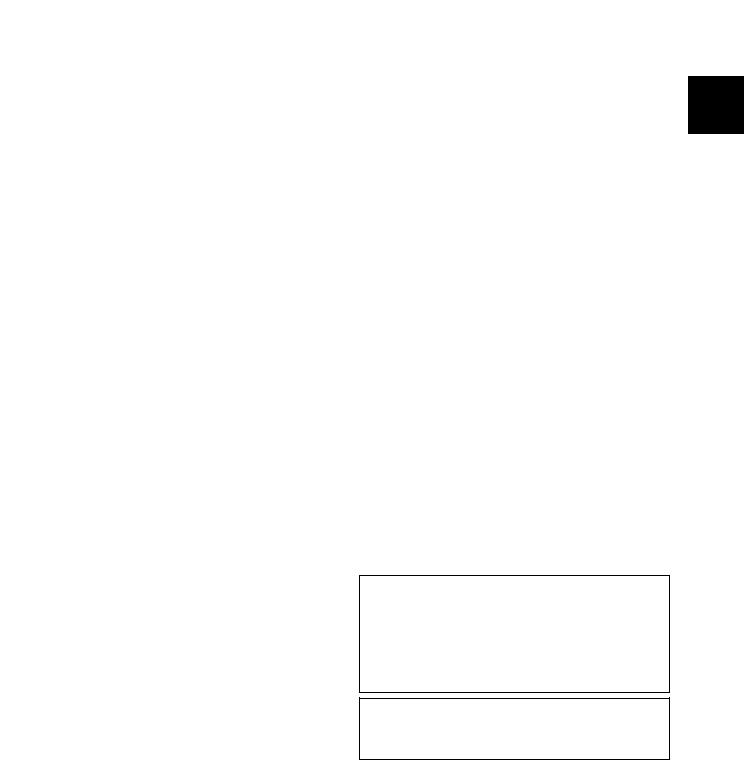
Operating Instructions
English
Français
Thank you very much for purchasing this PIONEER product. Before using your Plasma Display, please read the “Safety Precautions” and these “Operating Instructions” carefully so you will know how to operate the Plasma Display properly. Keep this manual in a safe place. You will find it useful in the future.
Notes on Installation Work:
This product is marketed assuming that it is installed by qualified personnel with enough skill and competence. Always have an installation specialist or your dealer install and set up the product. PIONEER cannot assume liabilities for damage caused by mistake in installation or mounting, misuse, modification or a natural disaster.
Note for Dealers:
After installation, be sure to deliver this manual to the customer and explain to the customer how to handle the product.
i
Safety Precautions
En

Safety Precautions
English
WARNING: THIS APPARATUS MUST BE EARTHED.
CAUTION: WHEN POSITIONING THIS EQUIPMENT
ENSURE THAT THE MAINS PLUG AND SOCKET IS EASILY ACCESSIBLE.
The following symbols are found on labels attached to the product. They alert the operators and service personnel of this equipment to any potentially dangerous conditions.
 WARNING
WARNING
This symbol refers to a hazard or unsafe practice which can result in personal injury or property damage.
 CAUTION
CAUTION
This symbol refers to a hazard or unsafe practice which can result in severe personal injury or death.
Safety Precautions
To ensure proper heat radiation, distance the unit slightly from other equipment, walls, etc. (normally more than 10 cm). Avoid the following installations which will block vents and cause heat to build up inside, resulting in fire hazards.
•Do not attempt to fit the unit inside narrow spaces where ventilation is poor
•Do not place on carpet
•Do not cover with cloth, etc.
•Do not place on its side
•Do not place it upside down
•If planning special installation such as fitting close to the wall, placing it horizontally, etc., be sure to consult your Pioneer dealer first.
Operating Environment |
H045 En |
Operating environment temperature and humidity:
0 °C – +40 °C (+32 °F – +104 °F); less than 85 %RH (cooling vents not blocked)
Do not install in the following locations
÷Location exposed to direct sunlight or strong artificial light
÷Location exposed to high humidity, or poorly ventilated location
ii
En

Contents
Safety Precautions ........................................................ |
i |
Features ........................................................................ |
2 |
Before Proceeding ........................................................ |
3 |
How to Use This Manual ................................................................ |
3 |
Checking Supplied Accessories ..................................................... |
5 |
Part Names and Functions .......................................... |
6 |
Main Unit ......................................................................................... |
6 |
Remote Control Unit ....................................................................... |
7 |
Connection Panel ............................................................................ |
8 |
Installation and Connections .................................... |
10 |
Installation of the Unit .................................................................. |
10 |
Connection to INPUT1 and INPUT2 ............................................. |
12 |
Audio Connections ....................................................................... |
14 |
Control Cord Connection .............................................................. |
15 |
Power Cord Connection ............................................................... |
15 |
How to Route Cables .................................................................... |
16 |
Setting Up the System .............................................. |
17 |
Setup after Connection ................................................................. |
17 |
Operations .................................................................. |
19 |
Selecting an Input Source ............................................................ |
19 |
Screen Size Selection ................................................................... |
21 |
Partial Image Enlargement (POINT ZOOM) ................................ |
23 |
Automatic Power OFF ................................................................... |
24 |
Display Panel Adjustments ....................................... |
25 |
Adjusting the Picture Quality ....................................................... |
25 |
Adjusting the Image Position and Clock |
|
(Automatic Adjustment) ............................................................... |
26 |
Manual Adjustment of Screen Position and Clock ..................... |
27 |
Other Operations ....................................................... |
28 |
Rewriting the Input Display (INPUT LABEL) ............................... |
28 |
Power Control Function ................................................................ |
29 |
AUTO FUNCTION .......................................................................... |
29 |
Audio Output (AUDIO OUT) ......................................................... |
30 |
Additional Information .............................................. |
31 |
Cleaning ......................................................................................... |
31 |
Troubleshooting ............................................................................ |
31 |
Specifications ................................................................................ |
34 |
Supplement 1 ................................................................................ |
35 |
Supplement 2 ................................................................................ |
37 |
Explanation of Terms .................................................................... |
37 |
English
Before Proceeding
1
En

English
Before Proceeding
Features
PDP-503MXE |
PDP-433MXE |
¶Introduces newly developed 50" XGA Wide Plasma Panel
The new wide high-precision XGA 50" plasma panel (1280x768 / 16:9) pushes the envelope of previous high-luminance panels, producing brighter, clearer images with higher contrast.
¶Newly developed full screen filter produces clear,
high-contrast images even in a lighted room.
The new full screen filter suppresses surface reflections to a minimum, producing clear, high-contrast images even in lighted locations. Unnecessary frequency components of RGB signals are also cut, greatly enhancing color reproduction.
¶Supports wide range of computer signal formats
Supports non-compressed display of signals ranging from 640x400 and 640x480 (VGA) to 1024x768 (XGA) and 1280x768, and compressed display of 1280x1024 (SXGA) and 1600x1200 (UXGA) signals. Further, aspect ratio and screen size settings supported include Dot-by-Dot, 4:3, FULL and PARTIAL*1.
*1 Aspect ratio and screen size appearance will differ depending on input signal.
¶Free Installation Configuration
Broader installation possibilities with thinner,
lighter, high-endurance design.
While producing a large 50" screen image, the display is only 98 mm thick, and weighs in at only 38.9 kg. On the other hand, the efficient heat-radiating design greatly improves environmental operating conditions. The thinner, lighter design, coupled to highendurance construction greatly broadens the range of possible installation locations and styles.
¶ High reliability for commercial applications
This display is provided with features giving it high dependability in commercial applications, including the ability to suppress peak luminance in accordance with the viewing program, and to change the cooling fan’s speed in accordance with changes in operating environment. Such features provide safety and highendurance under conditions of commercial use.
¶ Improved usability
User convenience has been improved by the inclusion of features making the display even more compatible with your computer. Some of these include the one-touch screen adjustment, AUTO SETUP function for computer connections, and the POINT ZOOM function to enlarge local portions of the screen image to display important detailed program data.
¶ Power-Saving Design
While equipped with a high-precision (1280x768) panel, this unit achieves the highest energy-saving of any display in its class (50inch XGA class: 380 W; 20% less than previous Pioneer products). In addition, when the Power Control function is selected, power consumption is reduced by 20% compared to the normal operating mode (MODE 1, with color-bar signal input).
¶Introduces newly developed 43" Wide Plasma Panel
The new wide high-precision 43" plasma panel (1024x768 / 16:9) pushes the envelope of previous high-luminance panels, producing brighter, clearer images with higher contrast.
¶Newly developed full screen filter produces clear,
high-contrast images even in a lighted room.
The new full screen filter suppresses surface reflections to a minimum, producing clear, high-contrast images even in lighted locations. Unnecessary frequency components of RGB signals are also cut, greatly enhancing color reproduction.
¶Supports wide range of computer signal formats
Supports non-compressed display of signals ranging from 640x400 and 640x480 (VGA) to 1024x768 (XGA), and compressed display of 1280x1024 (SXGA) and 1600x1200 (UXGA) signals. Further, aspect ratio and screen size settings supported include Dot-by-Dot, 4:3, and FULL*1.
*1 Aspect ratio and screen size appearance will differ depending on input signal.
¶Free Installation Configuration
Broader installation possibilities with thinner,
lighter, high-endurance design.
While producing a large 43" screen image, the display is only 98 mm thick, and weighs in at only 31.5 kg. On the other hand, the efficient heat-radiating design greatly improves environmental operating conditions. The thinner, lighter design, coupled to highendurance construction greatly broadens the range of possible installation locations and styles.
¶ High reliability for commercial applications
This display is provided with features giving it high dependability in commercial applications, including the ability to suppress peak luminance in accordance with the viewing program, and to change the cooling fan’s speed in accordance with changes in operating environment. Such features provide safety and highendurance under conditions of commercial use.
¶ Improved usability
User convenience has been improved by the inclusion of features making the display even more compatible with your computer. Some of these include the one-touch screen adjustment, AUTO SETUP function for computer connections, and the POINT ZOOM function to enlarge local portions of the screen image to display important detailed program data.
¶ Power-Saving Design
While equipped with a high-precision (1024x768) panel, this unit achieves the highest energy-saving of any display in its class (43inch class: 298 W). In addition, when the Power Control function is selected, power consumption is reduced by 20% compared to the normal operating mode (MODE 1, with color-bar signal input).
¶ Optional line (sold separately)
(For details, please consult the dealer where this unit was purchased.)
1 Table top stand: PDP-503MXE / PDP-433MXE display stand. 2 Wall installation unit: Wall installation bracket designed as a
wall interface for securing the unit.
3 Speaker system designed specifically for plasma displays (width: 7.4 cm): With the adoption of a vertical 2-way system
designed with a 2.5 cm domed conical tweeter and newly developed 4.5 cm wide oval shaped units arranged vertically. (When speakers are attached, the operation panel on this unit is not operable.)
4 Video card: Expansion card allows viewing of video signals and computer digital RGB signals (DVI compliant).
5 Cable cover: Dedicated cover to allow fashionable concealment of rear cable connections.
2
En
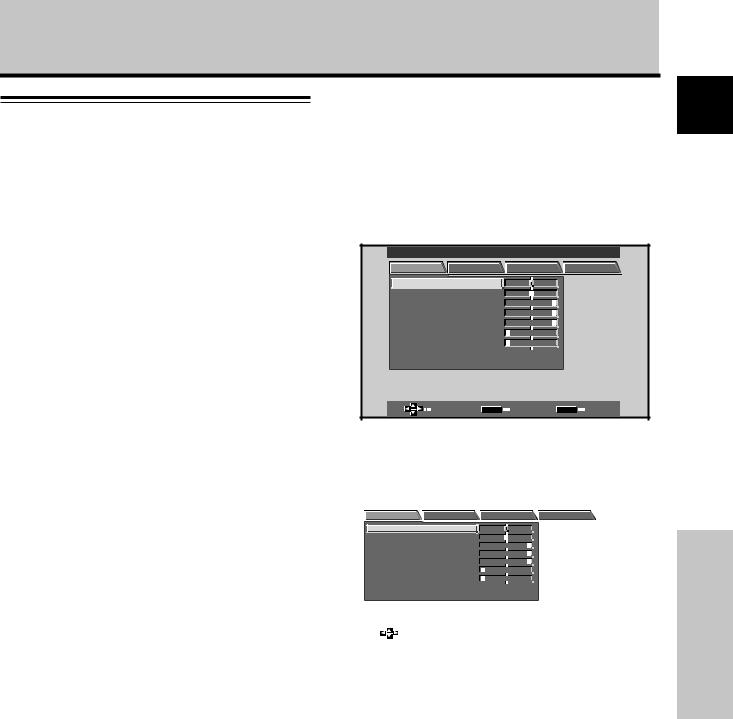
Before Proceeding
How to Use This Manual
This manual is set up to follow the course of actions and operations in the order that would seem most logical for someone setting up this unit.
Once the unit has been taken out of the box and it has been confirmed that all the parts have been received, it may be beneficial to look over the section “Part Names and Functions” starting on page 6 to become acquainted with the plasma monitor and remote control unit, as their respective buttons and controls will be referred to throughout this manual.
The section “Installation and Connections” starting on page 10 covers all the necessary points regarding installation of the plasma display and connections to a wide variety of components.
Screen Displays
The example screen displays provided in this manual are those for the PDP-503MXE model. The PDP-433MXE display differs as shown:
Example of PDP-503MXE Screen Display:
÷The PDP-503MXE screen display has a nondisplaying border at each side of the display.
MAIN MENU |
|
|
|
|
|
INPUT1 |
PICTURE |
SCREEN |
SET UP |
OPTION |
|||
CO NT RA S T |
|
: |
0 |
|
|
|
BR I GHT . |
|
: |
0 |
|
|
|
R. L E V E L |
|
: + 6 0 |
|
|
|
|
G. L E V E L |
|
: + 6 0 |
|
|
|
|
B. L E V E L |
|
: + 6 0 |
|
|
|
|
H. E NHAN CE |
: |
0 |
|
|
|
|
V . E NHAN CE |
: |
0 |
|
|
|
|
RE S E T |
|
|
|
|
|
|
SELECT |
|
SET |
ENTER |
MENU |
EXIT |
|
The section “Setting Up the System” starting on page 17 covers the necessary on-screen menu settings to establish correct linkage between the plasma display and connected components. Depending on the connections made, this section may or may not be necessary.
The remainder of the sections in this manual is dedicated to the basic operations associated with selecting a source component up to the more complex operations associated with adjusting the plasma display picture to match the requirements of specific components and personal preferences.
Example of PDP-433MXE Screen Display:
÷The PDP-433MXE screen display fills the display area in both horizontal directions.
MAIN MENU |
|
|
|
|
INPUT1 |
PICTURE SCREEN |
SET UP |
OPTION |
|||
C O N T R A S T |
: |
0 |
|
|
|
B R I GH T . |
: |
0 |
|
|
|
R. L E V E L |
: + 6 0 |
|
|
|
|
G. L E V E L |
: + 6 0 |
|
|
|
|
B. L E V E L |
: + 6 0 |
|
|
|
|
H. E NH AN CE |
: |
0 |
|
|
|
V . E NH AN CE |
: |
0 |
|
|
|
RE S E T |
|
|
|
|
|
|
|
|
|
|
|
SELECT |
|
|
ENTER |
|
EXIT |
|
SET |
MENU |
|||
|
|
|
|
|
|
Please note that the actual contents displayed are the same for both the PDP-503MXE and PDP-433MXE.
English
Before Proceeding
3
En
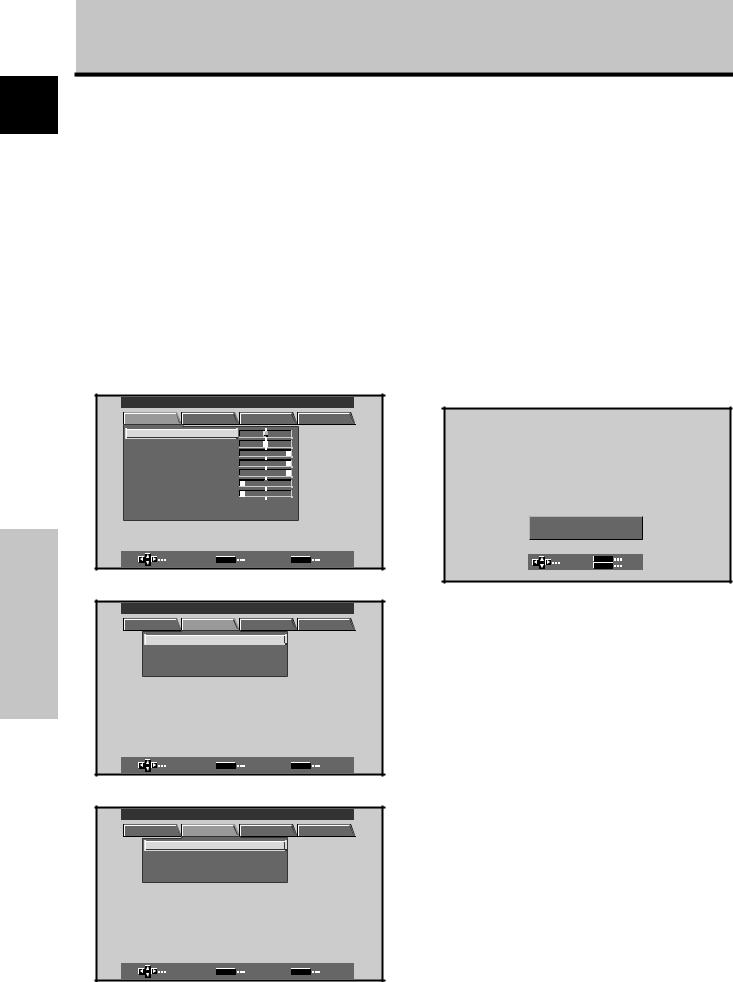
English
Before Proceeding
Before Proceeding
About operations in this manual
Operations in this manual are outlined in step by step numbered procedures. Most of the procedures are written in reference to the remote control unit unless the button or control is only present on the main unit. However, if a button or control on the main unit has the same or similar name as that on the remote control unit, that button can be used when performing operations.
The following example is an actual operation that shows how one might set the horizontal and vertical positions of the screen. The screens shown at each step are provided as a visual guide to confirm that the procedure is proceeding as it should. Please familiarize yourself with this process before continuing on with the rest of this manual.
1 Press MENU to display the menu screen. |
4 Press SET to display the adjustment screen for the |
|||||||
MAIN MENU |
|
|
|
|
|
INPUT1 |
selected item. |
|
PICTURE |
SCREEN |
SET UP |
OPTION |
|
|
|||
CO NT RA S T |
|
: |
0 |
|
|
|
|
|
BR I GHT . |
|
: |
0 |
|
|
|
|
|
R. L E V E L |
|
: + 6 0 |
|
|
|
|
|
|
G. L E V E L |
|
: + 6 0 |
|
|
|
|
|
|
B. L E V E L |
|
: + 6 0 |
|
|
|
|
|
|
H. E NHAN CE |
: |
0 |
|
|
|
|
|
|
V . E NHAN CE |
: |
0 |
|
|
|
|
|
|
RE S E T |
|
|
|
|
|
|
H . P O S I T I O N : |
0 |
|
|
|
|
|
|
|
||
|
|
|
|
|
|
|
V . P O S I T I O N : |
0 |
SELECT |
|
SET |
ENTER |
MENU |
EXIT |
ADJUST MENU |
EXIT |
|
|
|
|
|
|
|
|
SET |
SET |
2 Press 3 to select SCREEN.
MAIN |
MENU |
|
|
|
|
|
INPUT1 |
PICTURE |
SCREEN |
SET UP |
OPTION |
||||
|
P O S I T I O N |
: |
0 / |
0 |
|
|
|
CL OC K / PHA S E : |
0 / |
0 |
|
|
|||
|
RE S E T |
|
|
|
|
|
|
|
SELECT |
SET |
ENTER |
|
MENU |
EXIT |
|
3 Press 5/∞ to select the item to be adjusted.
MAIN |
MENU |
|
|
|
|
|
INPUT1 |
PICTURE |
SCREEN |
SET UP |
OPTION |
||||
|
P O S I T I O N |
: |
0 / |
0 |
|
|
|
CL OC K / PHA S E : |
0 / |
0 |
|
|
|||
|
RE S E T |
|
|
|
|
|
|
|
SELECT |
SET |
ENTER |
|
MENU |
EXIT |
|
4
5 Press 5/∞/2/3 to adjust the value.
Note
The screen displays depicted in this manual represent typical display examples.
The actual items and contents seen in screen displays may vary depending on input source and specific settings.
En
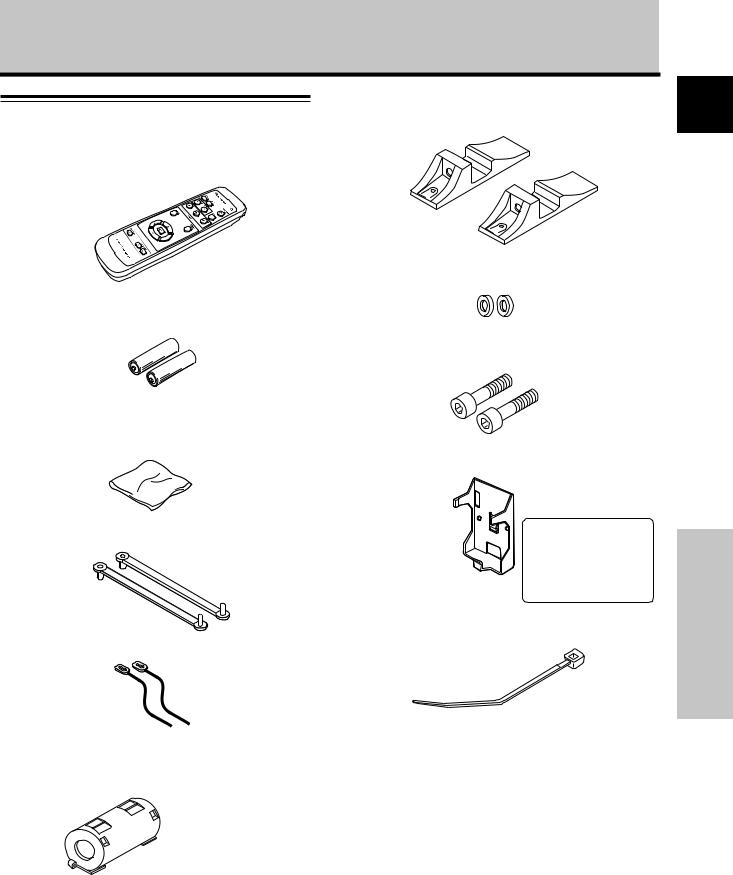
Before Proceeding
Checking Supplied Accessories
Check that the following accessories were supplied.
1 Remote control unit
2 AA (R6) batteries (x 2)
3 Cleaning cloth (for wiping front panel)
4 Speed clamps (x 2)
5 Bead bands (x 2)
7 Display stands (x 2)
8 Washers (x 2)
9 Hex hole bolts (x 2)
0 Remote control unit holder
Use as a holder for the remote control unit. When attaching to the rear of the main unit, be careful not to cover the vents.
- Cable tie
÷ Operating Instructions
6 Ferrite core
English
Before Proceeding
5
En
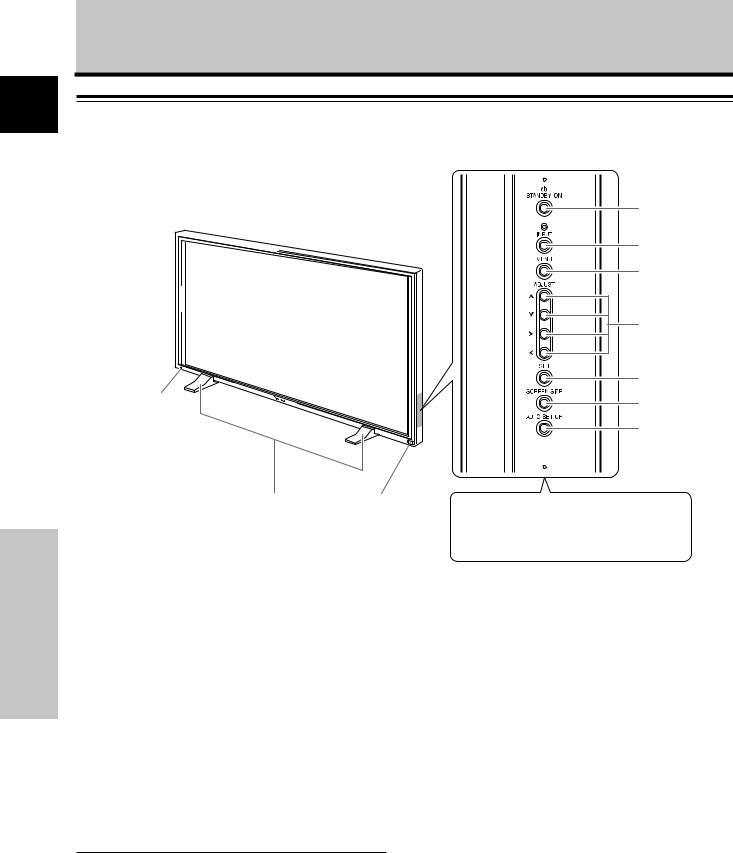
English
Part Names and Functions
Part Names and Functions
Main Unit
Main unit
3
1 2
Main unit
1 Display stand
2Remote control sensor
Point the remote control toward the remote sensor to operate the unit (page 8).
3STANDBY/ON indicator
This indicator is red during standby mode, and turns to green when the unit is in the operation mode (page 19).
Flashes green when Power-Management function is operating (page 24).
The flashing pattern is also used to indicate error messages (page 33).
Operation panel on the main unit
4STANDBY/ON button
Press to put the display in operation or standby mode (page 19).
5INPUT button
Press to select input (page 19).
Operation panel on the main unit
4
5
6
7 |
8
9
0
Note
When optional speakers have been connected, the operation panel on the main unit will not be operable.
6MENU button
Press to open and close the on-screen menu (pages 17 to 30).
7ADJUST (5/∞/3/2) buttons
Use to navigate menu screens and to adjust various settings on the unit.
Usage of cursor buttons within operations is clearly indicated in the on-screen display (pages 17 to 30).
8SET button
Press to adjust or enter various settings on the unit (pages 17 to 30).
9SCREEN SIZE button
Press to select the screen size (page 21).
0AUTO SET UP button
When using computer signal input, automatically sets the POSITION and CLOCK/PHASE to optimum values (page 26).
6
En
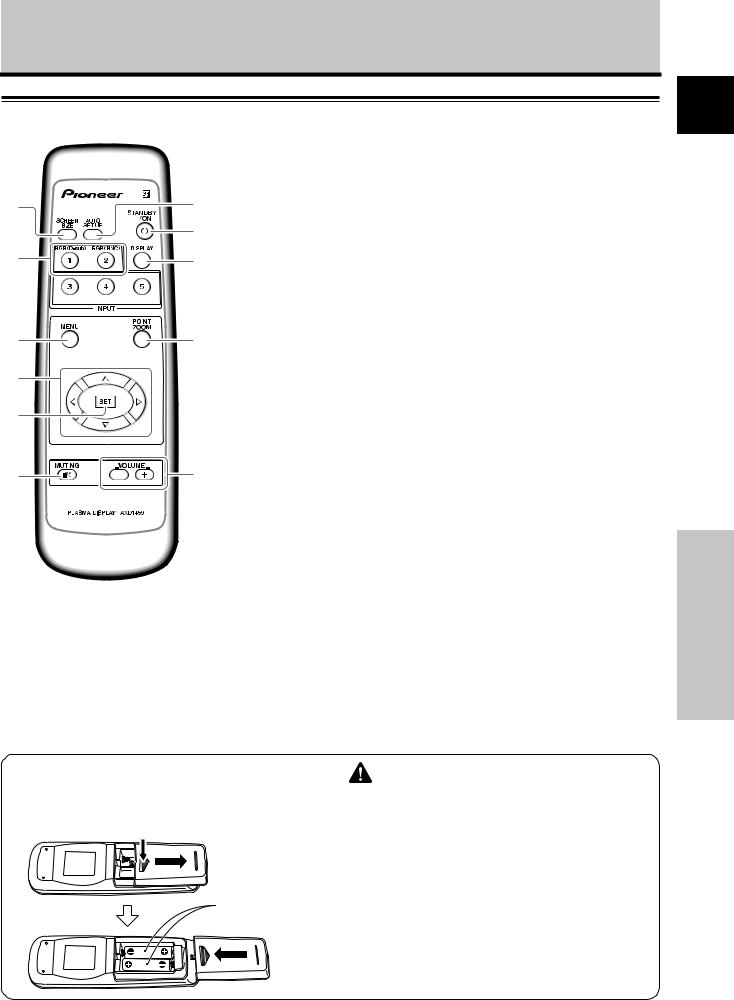
Part Names and Functions
Remote Control Unit
1SCREEN SIZE button
Press to select the screen size (page 21).
1 |
|
|
|
|
|
|
|
|
7 |
2 INPUT buttons |
|
|
|
|
|
|
|
|
|
Use to select the input (page 19). |
|||
|
|
|
|
|
|
|
|
|
|
|
|
2 |
|
|
|
|
|
|
|
|
|
8 |
3 MENU button |
|
|
|
|
|
|
|
|
|
|||
|
|
|
|
|
|
|
|
9 |
|||
|
|
|
|
|
|
|
|
||||
|
|
|
|
|
|
|
|
Press to open and close the on-screen menu |
|||
|
|
|
|
|
|
|
|
|
|
|
(pages 17 to 30). |
|
|
|
|
|
|
|
|
|
|
|
4 ADJUST (5/∞/3/2) buttons |
|
|
|
|
|
|
|
|
|
|
|
|
|
|
|
|
|
|
|
|
|
|
|
|
3 |
|
|
|
|
|
|
|
|
0 |
Use to navigate menu screens and to adjust various settings on the |
|
|
|
|
|
|
|
|
|
||||
|
|
|
|
|
|
|
|
||||
|
|
|
|
|
|
|
|
unit. |
|||
|
|
|
|
|
|
|
|
|
|
|
Usage of cursor buttons within operations is clearly indicated at the |
4 |
|
|
|
|
|
|
|
|
|
|
bottom the on-screen menu display (pages 17 to 30). |
|
|
|
|
|
|
|
|
|
|
|
|
5 |
|
|
|
|
|
|
|
|
|
|
5 SET button |
|
|
|
|
|
|
|
|
|
|
Press to adjust or enter various settings on the unit (pages 17 to 30). |
|
|
|
|
|
|
|
|
|
|
|
|
|
|
|
|
|
|
|
|
|
|
|
|
6 MUTING button |
6 |
|
|
|
|
|
|
|
|
- |
Press to mute the volume (page 20). |
|
|
|
|
|
|
|
|
|
||||
|
|
|
|
|
|
|
|
||||
|
|
|
|
|
|
|
|
|
|||
7AUTO SET UP button
When using computer signal input, automatically sets the POSITION and CLOCK/ PHASE to optimum values (page 26).
|
8 STANDBY/ON button |
|
|
Press to put the unit in operation or standby mode (page 19). |
|
|
|
|
When handling the remote control unit |
9 DISPLAY button |
|
¶ Do not drop or shake the remote control. |
Press to view the unit’s current input and setup mode (page 20). |
|
¶ Do not use the remote control unit in a location |
||
|
||
subject to direct sunlight, heat radiation from a |
0 POINT ZOOM button |
|
heater, or in a place subject to excessive |
||
humidity. |
Use to select and enlarge one part of the screen (page 23). |
|
¶ When the remote control unit’s batteries begin |
|
|
to wear out, the operable distance will gradually |
- VOLUME (+/–) buttons |
|
become shorter. When this occurs, replace all |
Use to adjust the volume (page 20). |
|
batteries with new ones as soon as possible. |
||
|
|
Inserting the batteries in the |
CAUTION |
|
remote control unit |
||
¶ Insert batteries so that the plus (+) and minus (–) sides are |
||
|
||
|
aligned according to the markings in the battery case. |
|
While pressing down lightly, slide |
¶ Do not mix new batteries with used ones. |
|
¶ The voltage of batteries may differ even if they are the same |
||
in the direction of the arrow. |
||
|
shape. Please do not mix different kinds of batteries |
|
|
together. |
|
|
¶ When not using the remote control unit for a long period of |
|
|
time (1 month or more), remove the batteries from the |
|
Two AA (R6) |
remote control unit to prevent leaking of battery fluid. If |
|
battery liquid has leaked, thoroughly wipe the inside of the |
||
batteries |
case until all liquid is removed, and then insert new batteries. |
|
|
¶ Do not charge, short, disassemble or throw the provided |
|
|
batteries in a fire. |
|
|
When disposing of used batteries, please comply with |
|
|
governmental regulations or environmental public |
|
|
instruction’s rules that apply in your country or area. H048 En |
7
English
Part Names and Functions
En

English
Part Names and Functions
Part Names and Functions
Operating range of the remote control unit
When operating the remote control unit, point it at the remote sensor (Î) located on the front panel of the main unit. The remote control unit is operable up to 7 m from the unit and within a 30 angle on each side of the sensor.
Connection Panel
The connection panel is provided with two video input terminals and one video output terminal. Audio input and speaker output terminals are also provided, together with a CONTROL IN/OUT connector for connecting to PIONEER components bearing the Î mark.
For instructions regarding connections, consult the pages noted in parentheses by each item.
1 SPEAKER (R) terminal
7 m
30°
30°
Remote Sensor
If you are having difficulty with operation of the remote control unit
¶The remote control unit may not operate if there are objects placed between it and the display.
¶Operational distance will gradually become shorter as the batteries begin to wear out, replace weak batteries with new ones as soon as possible.
¶This unit discharges infrared rays from the screen. Placing a video deck or other component that is operated by an infrared remote control unit near this unit may hamper that component’s reception of the remote control’s signal, or prevent it from receiving the signal entirely. Should this occur, move the component to a position further away from this unit.
¶Depending on the installation surroundings, this unit’s remote control unit may be influenced by the infrared rays discharged from the plasma display, hampering reception of its rays or limiting its operational distance. The strength of infrared rays discharged from the screen will differ according to the picture displayed.
For connection of an external right speaker. Connect a speaker that has an impedance of 8 -16 Ω (page 14).
2CONTROL IN/OUT (monaural mini jacks)
For connection of PIONEER components that bear the Î mark. Making CONTROL connection enables control of this unit as a component in a system
(page 15).
3COMBINATION IN/OUT
DO NOT MAKE ANY CONNECTIONS TO THESE TERMINALS.
These terminals are used in the factory setup.
4RS-232C
DO NOT MAKE ANY CONNECTIONS TO THIS TERMINAL.
This terminal is used in the factory setup.
5INPUT1 (mini D-sub 15 pin)
For connection of a personal computer (PC) or similar component. Make sure that the connection made corresponds to the format of the signal output from the connected component (pages 12 to 14).
6OUTPUT (INPUT1) (mini D-sub 15 pin)
Use the OUTPUT (INPUT1) terminal to output the video signal to an external monitor or other component.
Note: The video signal will not be output from the OUTPUT (INPUT1) terminal when the main power of this unit is off or in standby mode.
(page 13)
7INPUT2 (BNC jacks)
For connection of a personal computer (PC) or similar component. Make sure that the connection made corresponds to the format of the signal output from the connected component (pages 12 to 14).
8
En

Part Names and Functions
English
Illustration depicts PDP-503MXE model.
AC INLET
























 -
- 



 =
=
8Ω |
~16Ω |
L |
+ |
– |
|
SPEAKER |
|
|




 ~
~
8Ω |
~16Ω |
CONTROL |
COMBINATION |
RS-232C |
|
INPUT1 |
(ON SYNC) |
|
INPUT2 (H/V SYNC) |
|
AUDIO |
||||
|
|
IN |
OUT |
|
|
OUTPUT |
G |
B |
R |
HD |
VD |
INPUT |
OUTPUT |
||
SPEAKER |
IN |
OUT |
|
ANALOG RGB |
(ANALOG RGB) |
|
|
|
|
|
|||||
R + |
– |
|
|
|
|
|
|
|
|
|
|
|
2.2 |
(INPUT1/2) |
|
|
|
|
|
|
|
|
|
|
|
|
75Ω Ô kΩ |
|
|
||
1 |
2 |
|
3 |
4 |
5 |
6 |
|
|
7 |
|
89 0 |
||||
8 Synchronizing signal impedance selector switch |
- MAIN POWER switch |
Depending on the connections made at INPUT2, it |
Use to switch the main power of the unit on and off. |
may be necessary to set this switch to match the |
= AC INLET |
output impedance of the connected component’s |
|
synchronization signal. |
Use to connect a power cord to an AC outlet (page |
When the output impedance of the component’s |
15). |
synchronization signal is below 75 Ω , set this switch |
~ SPEAKER (L) terminal |
to the 75 Ω position (pages 12, 14). |
|
|
For connection of an external left speaker. Connect a |
9 AUDIO INPUT (Stereo mini jack) |
speaker that has an impedance of 8 -16 Ω (page 14). |
Use to obtain sound when INPUT1 or INPUT2 is selected.
Connect the audio output jack of components connected to INPUT1 or INPUT2 to this unit (page 14).
0AUDIO OUTPUT (Stereo mini jack)
Use to output the audio of the selected source component connected to this unit to an AV amplifier or similar component (page 14).
Part Names and Functions
9
En
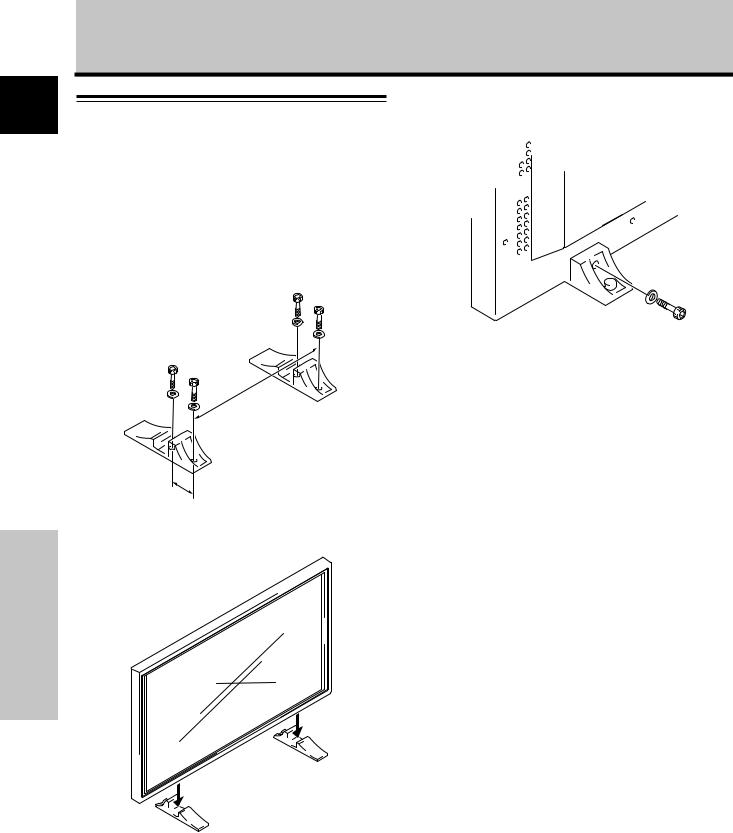
English
Installation and Connections
Installation and Connections
Installation of the Unit
Installation using the supplied display stand
Be sure to fix the supplied stand to the installation surface.
Use commercially available M8 bolts that are 25 mm longer than the thickness of the installation surface.
1Fix the supplied stand to the installation surface at each of the 4 prepared holes using commercially available M8 bolts .
Front
 PDP-503MXE: 798 mm
PDP-503MXE: 798 mm
PDP-433MXE: 768 mm
Rear
110 mm
2 Set this unit in the stand.
3 Fix this unit using the supplied washer and bolt.
Use a 6 mm hex wrench to bolt them.
 CAUTION
CAUTION
This display unit weighs at least 30 kg and has little front-to-back depth, making it very unstable when stood on edge. As a result, two or more persons should cooperate when unpacking, moving, or installing the display.
10
En
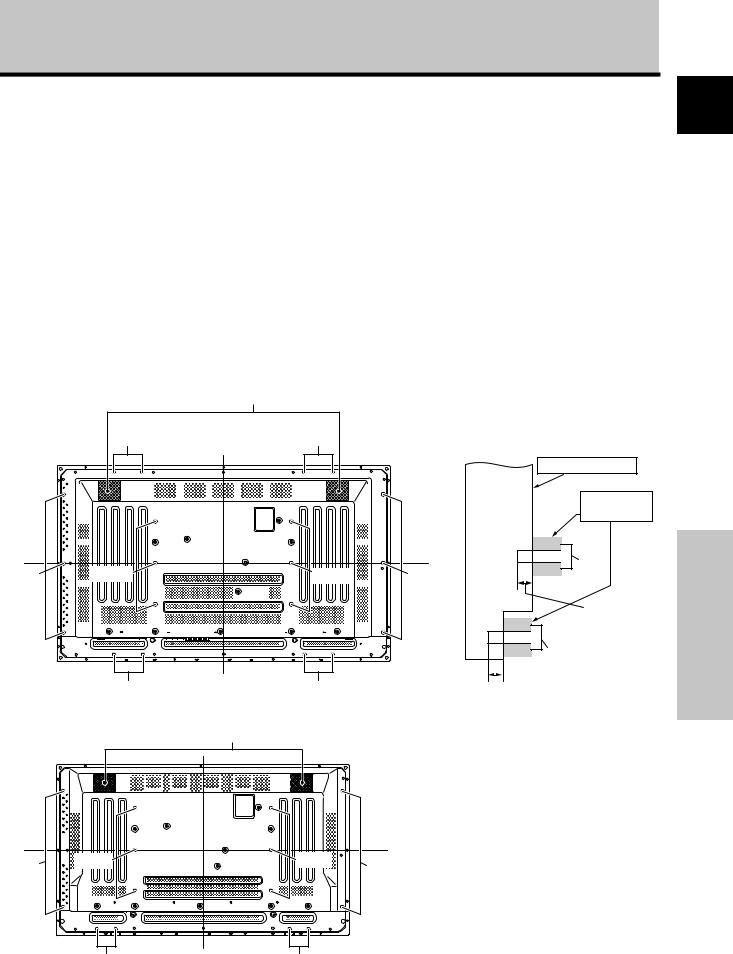
Installation and Connections
Installation using the optional PIONEER stand or installation bracket
÷Please be sure to request installation or mounting of this unit or the installation bracket by an installation specialist or the dealer where purchased.
÷When installing, be sure to use the bolts provided with the stand or installation bracket.
÷For details concerning installation, please refer to the instruction manual provided with the stand or installation bracket.
Installation using accessories other than the PIONEER stand or installation bracket (sold separately)
÷When possible, please install using parts and accessories manufactured by PIONEER. PIONEER will not be held responsible for accident or damage caused by the use of parts and accessories manufactured by other companies.
÷For custom installation, please consult the dealer where the unit was purchased, or a qualified installer.
Air vents (fan)
Wall-mount installation of the unit
This unit has been designed with bolt holes for wall-mount installation, etc. The installation holes that can be used are shown in the diagram below.
÷Be sure to attach in 4 or more locations above and below, left and right of the center line.
÷Use bolts that are long enough to be inserted 12 mm to 18 mm into the main unit from the attaching surface for both a holes and b holes. Refer to the side view diagram below.
÷As this unit is constructed with glass, be sure to install it on a flat, unwarped surface.
 CAUTION
CAUTION
To avoid malfunction, overheating of this unit, and possible fire hazard, make sure that the vents on the main unit are not blocked when installing. Also, as hot air is expelled from the air vents, be careful of deterioration and dirt build up on rear surface wall, etc..
|
b hole |
|
b hole |
|
|
|
|
|
|
|
Attaching surface |
|
|
|
|
|
Installation |
|
|
|
|
|
bracket, etc.. |
|
|
|
|
Main unit |
a hole |
|
|
|
|
|
|
|
|
|
|
Center line |
Bolt |
b hole |
a hole |
|
a hole |
b hole |
|
|
|
||||
|
|
|
|
|
12 mm to 18 mm |
|
|
|
|
|
Bolt |
|
|
|
|
b hole |
|
|
b hole |
Center line |
b hole |
12 mm to 18 mm |
|
|
|
|
|||
|
|
|
|
|
|
Rear view diagram (PDP-503MXE) |
Side view diagram |
Air vents (fan)
|
|
|
Center line |
b hole |
a hole |
|
a hole |
|
|
b hole |
|
|
b hole |
Center line |
b hole |
|
|
Rear view diagram (PDP-433MXE)
 CAUTION
CAUTION
Please be sure to use an M8 (Pitch = 1.25 mm) bolt. (Only this size bolt can be used.)
 CAUTION
CAUTION
This display unit weighs at least 30 kg and has little front-to-back depth, making it very unstable when stood on edge. As a result, two or more persons should cooperate when unpacking, moving, or installing the display.
 CAUTION
CAUTION
This unit incorporates a thin design. To ensure safety if vibrated or shaken, please be sure to take measures to prevent the unit from tipping over.
11
English
Français
Installation and Connections
En

English
Installation and Connections
Installation and Connections
Connection to INPUT1 and INPUT2
The INPUT 1 and INPUT 2 terminals are used to connect the display to a computer. After making the connections, adjust the screen settings in accordance with the computer’s signal output. See pages 17-18 for information regarding settings.
|
INPUT2 |
[ON SYNC] |
|
|
[H/V SYNC] |
|
Output |
jack |
G |
B |
R |
HD |
VD |
|
|
|
|
|
|
|
source |
|
|
|
|
|
|
Personal |
|
|
|
|
|
|
computer (PC) |
SYNC ON G |
B |
R |
|
|
|
with RGB output |
|
|
||||
|
|
G |
B |
R |
H/V SYNC |
|
|
|
G |
B |
R |
HD |
VD |
 : Do not connect anything.
: Do not connect anything.  : Connect to this jack.
: Connect to this jack.
Note
Components compatible with INPUT1 are also compatible with INPUT2.
INPUT1 is compatible with Microsoft’s Plug & Play (VESA DDC 1/2B).
When making connections to INPUT1, please refer to supplement 2 on page 37.
For the screen sizes and input signals that INPUT1 and INPUT2 are compatible with, please refer to supplement 1 (pages 35 and 36).
Connection to a personal computer
Connection method differs depending on the computer type. When connecting, please thoroughly read the computer’s instruction manual.
Before making connections, be sure to make sure that the personal computer’s power and this unit’s main power is off.
For the PC input signals and screen sizes that this unit is compatible with, please refer to supplement 1 (pages 35 and 36).
Connection of separate SYNC analog RGB
source
Make separate SYNC connections for a personal computer that has RGB output separated into 5 output signals: green, blue, red, horizontal synchronization signal, and vertical synchronization signal.
When connecting to INPUT2
(ON SYNC) |
|
INPUT2 |
(H/V SYNC) |
|
G |
B |
R |
HD |
VD |
75Ω Ô2k.Ω2
When using INPUT2, set the impedance selector switch to match the output impedance of the connected computer’s synchronization signal.
When the output impedance of the computer’s synchronization signal is below 75 Ω , set this switch to the 75 Ω position.
On-screen setup is necessary after connection. Please see pages 17 and 18.
12
En

When connecting to INPUT1
|
INPUT1 |
ANALOG RGB |
OUTPUT |
(ANALOG RGB) |
Installation and Connections
Connection of SYNC ON G analog RGB source
Make SYNC ON G connections for a personal computer with output that has the synchronization signal layered on top of the green signal.
When connecting to INPUT1
|
INPUT1 |
ANALOG RGB |
OUTPUT |
(ANALOG RGB) |
English
Français
Connect the cable corresponding to the shape of the input terminal on this unit and the personal computer’s output terminal.
Secure by tightening the terminal screws on both units.
After connecting, on-screen setup is necessary. Please see pages 17 and 18.
Note
Depending on the type of computer model being connected, a conversion connector or adapter etc. provided with the computer or sold separately may be necessary.
For details, please read your PC’s instruction manual or consult the maker or nearest dealer of your computer.
When connecting to OUTPUT (INPUT1)
|
|
INPUT1 |
OUTPUT |
|
||
ANALOG RGB |
|
|
||||
(ANALOG RGB) |
|
|||||
|
|
|
|
|
|
|
|
|
|
|
|
|
|
|
|
|
|
|
|
|
|
|
|
|
|
|
|
To an external monitor
With this unit, it is possible to output the video signal to an external monitor or other component from the OUTPUT (INPUT1) terminal.
Note
A video signal will not be output from the OUTPUT (INPUT1) terminal when the main power of this unit is off or in standby.
On screen setup is necessary after connection.
Please see pages 17 and 18.
When connecting to INPUT2
(ON SYNC) |
|
INPUT2 |
(H/V SYNC) |
ConnectionsandInstallation |
G |
B |
R |
HD |
VD |
|
|
|
|
75Ω Ô2.2kΩ |
On screen setup is necessary after connection.
Please see pages 17 and 18.
Note
When making SYNC ON G connections, do not make any connections to the VD or HD terminals. If connections are made, the picture may be not displayed normally.
13
En

English
Installation and Connections
Installation and Connections
Connection of composite SYNC analog RGB
source
Make composite SYNC connections for a personal computer with output that has the vertical synchronization signal layered on top of the horizontal synchronization signal.
Audio Connections
Before making connections, be sure to check that the audio component’s power and the unit’s main power is off.
Connecting the speakers
When connecting to INPUT1
|
INPUT1 |
ANALOG RGB |
OUTPUT |
(ANALOG RGB) |
This unit is equipped with speaker output terminals for connection to the speaker system (not supplied) specially designed for use with this unit. Refer to the illustrations below when making connections to the speaker terminals on this unit.
10 |
mm |
Twist exposed |
|
wire strands |
|||
|
|||
|
|
||
|
|
together. |
On-screen setup is necessary after connection. Please see pages 17 and 18.
When connecting to INPUT2
(ON SYNC) |
|
INPUT2 |
(H/V SYNC) |
|
G |
B |
R |
HD |
VD |
75Ω Ô2k.Ω2
When using INPUT2, set the impedance selector switch to match the output impedance of the connected computer’s synchronization signal.
When the output impedance of the computer’s synchronization signal is below 75 Ω , set this switch to the 75 Ω position.
On-screen setup is necessary after connection. Please see pages 17 and 18.
Notes
÷When making composite SYNC connections, do not connect anything to the VD jack. If connected, the picture may not be displayed properly.
÷On some types of Macintosh® components, SYNC ON G and composite SYNC are both output. With this type of component, please connect using the SYNC ON G connection (see page 13).
Push tab to the open position, and insert the wire. Then, close tab firmly to secure the wire in place.
Note
When making speaker connections, be sure to match the polarities (+ and –) of the speaker terminals on this unit and the corresponding terminals on the speakers. If the polarity is reversed, the sound will be unnatural and lack bass.
Making connections to the audio inputs on this unit
This unit features two audio inputs and one audio output. The following chart shows the video inputs and the corresponding audio input terminals.
Video |
Audio input jacks |
Sound output |
|
input |
|||
|
|
||
|
|
|
|
INPUT1 |
|
Sound of the selected video |
|
Stereo mini jack |
input is output from the |
||
|
|||
INPUT2 |
(L/R) |
• SPEAKER terminals |
|
|
• Stereo mini jacks (L/R). |
||
|
|
||
|
|
|
Audio connections for component (computer) connected to INPUT 1 or INPUT 2
|
|
AUDIO |
VD |
|
INPUT OUTPUT |
|
75Ω Ô2k.Ω2 |
(INPUT1/2) |
|
|
Audio input to the 
 AUDIO INPUT terminals
AUDIO INPUT terminals  (stereo mini jack) is
(stereo mini jack) is  possible for a
possible for a
component connected to either INPUT1 or INPUT2. Sound is output from both the AUDIO OUTPUT jacks (stereo mini jack) and the SPEAKER terminals according to the video input selection.
14
En

Installation and Connections
Control Cord Connection
When control cord connections are made, remote control operation of connected PIONEER components that bear the Î logo mark is done through the remote sensor on this unit.
When the connection is made to the CONTROL IN terminal on another unit, the remote sensor of that component will no longer receive signals. Point the remote control unit of the connected component at the remote control sensor on this unit to control.
Notes
÷Make sure the power is turned off when making connections.
÷Please complete all component connections before making control cord connections.
CONTROL
IN
Main unit
OUT
CONTROL
IN OUT
CONTROL
IN
OUT
CONTROL
IN
OUT
The control cables (not supplied) are monaural cables with mini plugs (no resistance).
Power Cord Connection
Connect a power cord after all component connections have been completed.
PDP-503MXE / PDP-433MXE power cord ratings
Cord .......................... |
Cross-sectional area 3 x 1.0 mm2 |
|
(According to CEE 13) |
Connector ................................................... |
10 A, 250 V |
|
(According to EN60320 Sheet C13) |
Plug ................................ |
International use (10 A, 250 V) |
Example:
UK : UK 13 Amp Plug with rated 13 Amp fuse (According to BS1363)
EURO : 10 A/16 A 250 V (According to CEE 7, 1 V)
 CAUTION
CAUTION
÷Do not use a power supply voltage other than that indicated (AC 100 - 240 V, 50/60 Hz) as this may cause fire or electric shock.
÷For the plasma display, a three-core power cord with a ground terminal is used for efficiency protection. Always be sure to connect the power cord to a three-pronged grounded outlet and make sure that the cord is properly grounded. If you use a power source converter plug, use an outlet with a ground terminal and screw down the ground line.
Attaching the Ferrite Core
To help prevent noise, attach the accessory ferrite core to the plug end of the power cord as shown in the accompanying illustration. Use the provided cable tie to prevent the ferrite core from slipping on the cable.
Ferrite core
Cable tie
To power |
|
|
|
|
|
|
|
|
|
|
|
|
||
|
|
|
|
|
|
AC power cord |
|
|
|
|
||||
|
|
|
|
|
|
|
|
|
|
|||||
|
|
|
|
|
|
|
|
|
|
|||||
outlet |
|
|
|
|
|
|
|
|
|
|
|
|
||
|
|
|
|
|||||||||||
|
|
|
|
|
|
|
|
|
To AC INLET |
|||||
|
|
|
|
|
|
|
|
|
|
|||||
|
As close as possible |
|||||||||||||
English
Français
Installation and Connections
15
En
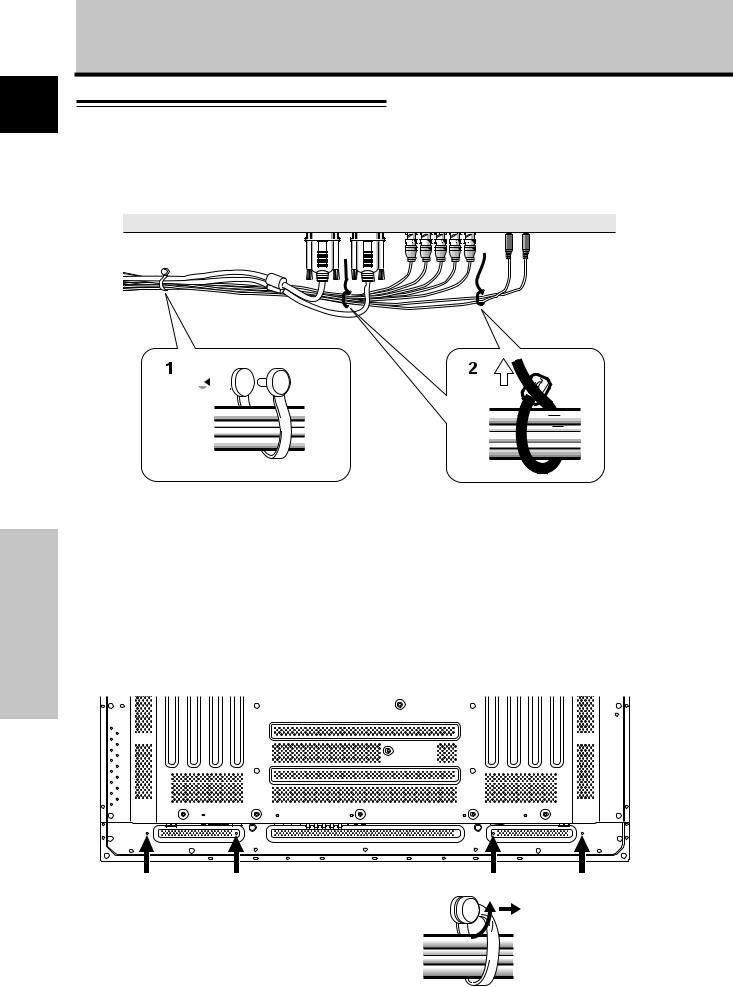
English
Installation and Connections
How to Route Cables
Speed clamps and bead bands are included with this unit for bunching cables together. Once components are connected, follow the following steps to route cables.
* As viewed from the rear of the display.
1 

 2
2
Installation and Connections
1 Organize cables together using the provided |
2 Bunch separated cables together and secure |
|
speed clamps. |
||
Insert 1 into an appropriate hole on the rear of the |
them with the provided bead bands. |
|
unit, then snap 2 into the back of 1 to fix the clamp. |
|
|
Speed clamps are designed to be difficult to undo |
Note |
|
Cables can be routed to the right or left. |
||
once in place. Please attach carefully. |
||
|
||
To attach the speed clamps to the main unit |
|
|
Connect the speed clamps using the 4 holes marked with • |
|
|
(Black dot) below, depending on the situation. |
|
Illustration depicts PDP-503MXE model.
To remove speed clamps
Using pliers, twist the clamp 90° and pull it outward. In some cases the clamp may have deteriorated over time and may get damaged when removed.
16
En

Setting Up the System |
|
|
|
|
|
|
|
|
|
Setup after Connection |
6 Press 5/∞ to select SETTING, then press SET. |
English |
|||||||
|
MAIN |
MENU |
|
|
|
|
INPUT1 |
|
|
After components have been connected to INPUT1 or |
PICTURE |
SCREEN |
SET UP |
OPTION |
|
||||
|
I NP UT L A B E L |
|
: I NP UT 1 |
|
|
||||
INPUT2, on-screen setup is necessary. |
|
|
|
|
|||||
|
POWE R |
MA NAGEME NT : OF F |
|
|
|
||||
Follow the procedure described below and make settings |
|
C L AMP |
P O S I T I O N |
: A U T O |
|
|
|
||
as they apply to the type of components connected. |
|
S E T T I N G |
|
: V GA |
|
|
Français |
||
|
|
|
|
|
|
|
|
||
Screen Mode setup |
|
|
|
|
|
|
|
|
|
|
|
|
|
|
|
|
|
|
|
Note |
|
|
|
|
|
|
|
|
|
These settings are required only when using the following input |
|
|
|
|
|
|
|
|
|
signal refresh rates: 1 31.5 kHz horizontal / 60 Hz vertical; 2 |
|
SELECT |
SET |
ENTER |
MENU |
EXIT |
|
||
|
|
|
|
|
|
|
|
|
|
48.4 kHz horizontal / 60 Hz vertical, or 56.5 kHz horizontal / 70 Hz |
7 Press 2/3 to select the display mode. |
|
|
||||||
vertical. No manual setup is necessary for signals with other |
|
|
|||||||
refresh rates, since adjustments are performed automatically (the |
|
|
|
|
|
|
|
|
|
SETTING item will not be displayed). |
|
|
|
|
|
|
|
|
|
1Switch MAIN POWER on the connection panel to the on position to turn on the unit’s main power.
The STANDBY/ON indicator lights red.
2Press STANDBY/ON to put the unit in the
operation mode. |
|
|
|
|
S E T T I N G : V G A |
|
|
|
|||
The STANDBY/ON indicator turns green. |
|
|
|
|
|
|
|||||
|
|
|
|
|
|
SELECT |
SET |
SET |
MENU |
EXIT |
|
3 Select INPUT1 or INPUT2. |
|
|
|
|
|
|
|
|
|||
4 Press MENU to display the menu screen. |
1 When the input signal has a refresh rate of 31.5 |
|
|||||||||
kHz (horizontal) and 60 Hz (vertical), pressing 2/3 |
|
||||||||||
The menu screen appears. |
|
|
will cause the display mode to change alternately |
|
|||||||
MAIN MENU |
|
|
|
|
INPUT1 |
as follows: |
|
|
|
|
System |
PICTURE |
SCREEN |
SET UP |
OPTION |
VGA |
|
WIDE VGA |
|
||||
|
|
|
|||||||||
CO NT RA S T |
|
: |
0 |
|
|
|
|
|
|
|
the |
BR I GHT . |
|
: |
0 |
|
|
|
|
|
|
|
|
R. L E V E L |
|
: + 6 0 |
|
|
2 When the input signal has a refresh rate of 48.4 |
Up |
|||||
G. L E V E L |
|
: + 6 0 |
|
|
|||||||
|
|
|
kHz horizontal / 60 Hz vertical, or 56.5 kHz |
Setting |
|||||||
B. L E V E L |
|
: + 6 0 |
|
|
|||||||
H. E NHAN CE |
: |
0 |
|
|
horizontal / 70 Hz vertical, pressing 2/3 will cause |
|
|||||
V . E NHAN CE |
: |
0 |
|
|
|
||||||
RE S E T |
|
|
|
|
|
the display mode to change alternately as follows: |
|
||||
|
|
|
|
|
|
|
|
|
|
|
|
|
|
|
|
|
|
XGA |
|
WIDE XGA |
|
|
|
SELECT |
|
SET |
ENTER |
MENU EXIT |
8 When the setup is completed, press MENU to exit |
|
|||||
|
|
|
|
|
|
|
|||||
5 Press 2/3 to select SET UP.
MAIN |
MENU |
|
|
|
|
|
INPUT1 |
PICTURE |
SCREEN |
SET UP |
OPTION |
||||
|
I NP UT L A B E L |
|
: I NP UT 1 |
||||
|
POWE R |
MA NAGEME NT : OF F |
|
|
|||
|
C L AMP |
P O S I T I O N |
: A U T O |
|
|
||
|
S E T T I N G |
|
: V G A |
|
|
||
|
SELECT |
SET |
ENTER |
MENU |
EXIT |
||
the menu screen.
Note
Make this setup for each input (INPUT1 and INPUT2).
17
En

English
Setting Up the System
Setting Up the System
CLAMP POSITION setup
Depending on the signal, analog RGB signals may result in the screen image appearing with a whitish or greenish cast. In such cases, set “CLAMP POSITION” to LOCKED. ÷ Normally, leave this setting at AUTO.
Setup of CLAMP POSITION
1Press MENU to display the menu screen.
The menu screen appears.
MAIN MENU |
|
|
|
|
|
INPUT1 |
PICTURE |
SCREEN |
SET UP |
OPTION |
|||
CO NT RA S T |
|
: |
0 |
|
|
|
BR I GHT . |
|
: |
0 |
|
|
|
R. L E V E L |
|
: + 6 0 |
|
|
|
|
G. L E V E L |
|
: + 6 0 |
|
|
|
|
B. L E V E L |
|
: + 6 0 |
|
|
|
|
H. E NHAN CE |
: |
0 |
|
|
|
|
V . E NHAN CE |
: |
0 |
|
|
|
|
RE S E T |
|
|
|
|
|
|
SELECT |
|
SET |
ENTER |
MENU |
EXIT |
|
2 Press 2/3 to select SET UP.
MAIN |
MENU |
|
|
|
|
|
INPUT1 |
PICTURE |
SCREEN |
SET UP |
OPTION |
||||
|
I NP UT L A B E L |
|
: I NP UT 1 |
||||
|
POWE R |
MA NAGEME NT : OF F |
|
|
|||
|
C L AMP |
P O S I T I O N |
: A U T O |
|
|
||
|
S E T T I N G |
|
: V G A |
|
|
||
|
SELECT |
SET |
ENTER |
MENU |
EXIT |
||
4 Press SET to select LOCKED.
MAIN |
MENU |
|
|
|
|
INPUT1 |
|
PICTURE |
SCREEN |
SET UP |
OPTION |
||||
|
I NP UT L A B E L |
|
: I NP UT 1 |
|
|||
|
POWE R |
MA NAGEME NT : OF F |
|
||||
|
C L A MP P OS I T I O N |
: L OCK E D |
|
||||
|
S E T T I N G |
|
: V G A |
|
|||
|
SELECT |
SET |
CHANGE |
MENU |
EXIT |
||
Mode selection will change as follows each time SET is pressed.
3 AUTO
LOCKED 2
5When the setup is completed, press MENU to exit the menu screen.
Notes
÷Make this CLAMP POSITION setting for each applicable input (INPUT1 and INPUT2).
÷When using this setup, be sure to carefully check the signal output of the component that you are using. For details, please refer to the instruction manual supplied with the component you are connecting.
3 Press 5/∞ to select CLAMP POSITION.
MAIN |
MENU |
|
|
|
|
|
INPUT1 |
PICTURE |
SCREEN |
SET UP |
OPTION |
||||
|
I NP UT L A B E L |
|
: I NP UT 1 |
||||
|
POWE R |
MA NAGEME NT : OF F |
|
||||
|
C L A MP P OS I T I O N |
: A U T O |
|
||||
|
S E T T I N G |
|
: V G A |
|
|||
|
SELECT |
SET |
CHANGE |
MENU |
EXIT |
||
18
En
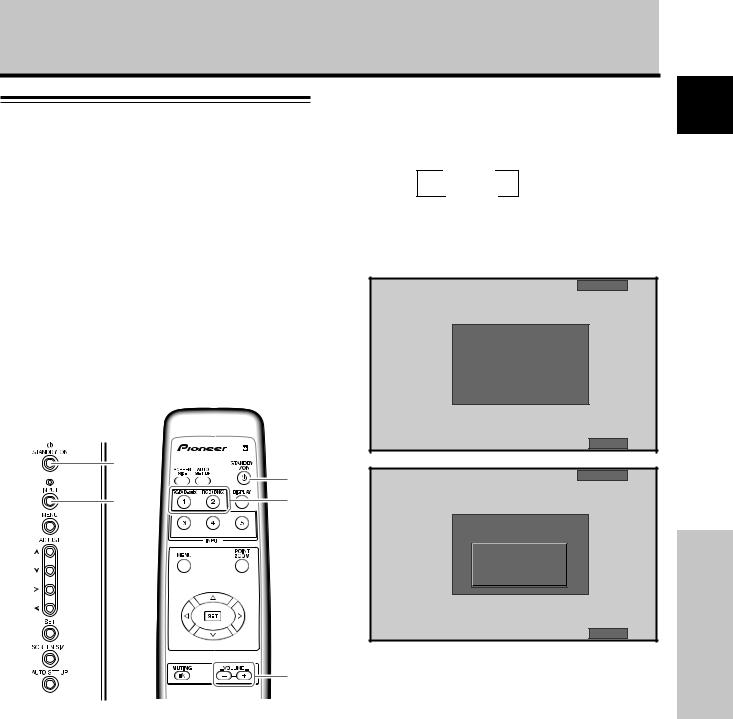
Operations
Selecting an Input Source
This section explains the basic operation of this unit. Outlined on the following pages is how to turn the main power on and off, put this unit in the operation or standby mode and how to select connected components.
Before you begin, make sure you have:
•Made connections between this unit and personal computer as described in the section “Installation and Connections” starting on page 10.
•Set up the on-screen menu to input signals from components connected to INPUT1 and INPUT2 as described in the section “Setting Up the System” on page 17.
If no connections are made to these terminals, on-screen setup is not necessary.
2,5
2,5
3 |
3 |
4
Main Unit Operating |
Remote Control Unit |
Panel |
|
1Switch MAIN POWER on the main unit to the on position to turn the main power on.
The STANDBY/ON indicator lights red.
2Press STANDBY/ON to put this unit in the operation mode.
The STANDBY/ON indicator turns green.
3Press INPUT on the remote control unit or the main unit to select the input.
Input changes each time the main unit’s INPUT is pressed as follows.
3INPUT1 INPUT2 2
•When the menu screen is displayed, changing the signal input will cause the menu screen to turn off.
•If the input computer signal is not supported by the display, the following message will be displayed:
I N P U T 1
CA U T I O N
UN S UP P O RT E D S I G N AL
f H : |
7 7 . |
1 |
k H z |
|
f V : |
8 5 . |
0 |
H z |
|
1 1 |
5 2 X 8 6 |
4 |
||
|
|
|
|
|
F U L L
I N P U T 1
CA U T I O N
OU T OF R AN G E
f H : 7 5 . 7 k H z f V : 1 2 0 . 0 H z
– – – –
F U L L
4Use VOLUME +/– on the remote control unit to adjust the volume.
If no audio connections are made to this unit, this step is not necessary.
5When viewing is finished, press STANDBY/ON to put the unit in standby mode.
The STANDBY/ON indicator will blink and then remain lit (red) indicating that the standby mode is engaged. Operation is not possible while the STANDBY/ON indicator is blinking (red).
6Switch MAIN POWER on the main unit to the off position to turn the main power off.
The STANDBY/ON indicator may continue to light for a short while even after the main power is turned off. This is a result of residual electric load impressed on the circuitry, and the light will turn off presently.
CAUTION
Please do not leave the same picture displayed on the screen for a long time. Doing so may cause a phenomenon known as “screen burn” which leaves a ghost, or residual, image of the picture on the screen.
19
English
Operations
En
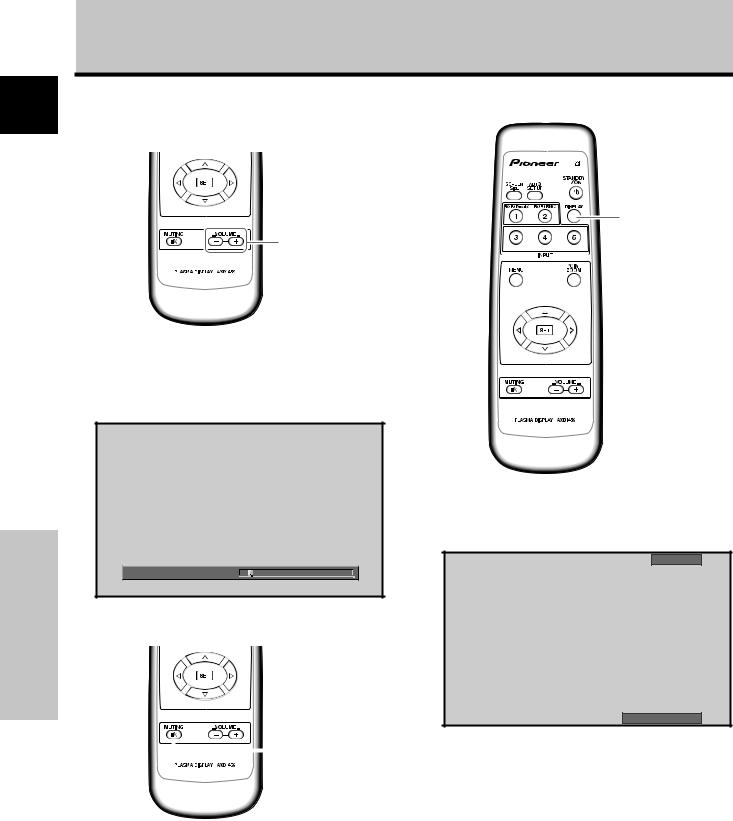
English
Operations
To adjust the volume |
To confirm display settings |
DISPLAY
VOLUME +/–
Press VOLUME on the remote control unit.
Use VOLUME + or VOLUME – to adjust the volume of the connected speakers.
Operations |
V O L U ME |
: 5 |
|
To mute the sound |
|||
|
|||
 MUTING
MUTING
ress MUTING on the remote control unit.
Press MUTING again to restore the sound.
Muting is automatically canceled about 8 minutes after the button is pressed, and the volume level is adjusted to the minimum level.
Press VOLUME + or VOLUME – to adjust the volume at a desired level.
Press DISPLAY on the remote control unit.
The currently selected input, screen size and refresh rates will be displayed for about 3 seconds.
I N P U T 1
f H : |
3 1 . |
5 |
k H z |
|
f V : |
6 0 . |
0 |
H z |
|
6 4 0 X 4 8 |
0 |
|||
|
|
|
|
|
DOT BY D OT
Note
The displayed refresh rates may be slightly different from actual values.
20
En

Operations
Screen Size Selection
This unit incorporates screen modes of various height and width ratios. For optimal viewing, we recommend that you select the screen mode that best matches the video source that you are viewing. Although these modes are designed for full display of a picture on a wide screen, it is our hope that you make use of them with a full understanding of the manufacturer’s intentions.
Changing the screen size
The size of the image displayed on the screen, and the range of the image shown can be set in one of four modes on the PDP-503MXE, and in three modes on the PDP-433MXE.
Press SCREEN SIZE to select the size.
The screen size changes each time SCREEN SIZE is pressed as follows.
[PDP-503MXE]
|
3 DOT BY DOT |
3 4:3 |
|
||||
|
|
||||||
|
|
|
|
|
|
|
|
|
|
PARTIAL 2 |
|
|
FULL 2 |
|
|
|
|
|
|
|
|
||
|
|
|
|
|
|
|
|
[PDP-433MXE]
|
3 DOT BY DOT |
3 4:3 |
|
||
|
|
||||
|
|
|
|
|
|
|
|
|
FULL 2 |
|
|
|
|
|
|
|
|
|
|
|
|
|
|
Consult the table Computer Signal Formats Supported (pages 35 and 36) for information regarding screen sizes supported by each signal format.
Notes
÷When the PARTIAL or FULL setting is used to display a nonwide screen 4:3 picture fully on a wide screen, a portion of the picture may be cut off or appear deformed.
÷Be aware that when the display is used for commercial or public viewing purposes, selecting the PARTIAL or FULL mode settings may violate the rights of authors protected under copyright law.
÷When DOT BY DOT or 4:3 screen sizes are selected, the display position is moved slightly each time the power is turned on, in order to prevent image burning.
During personal computer signal input
1 DOT BY DOT
The input signal and the screen maintain a dot to line ratio of 1:1 and is thus highly faithful to the source.
[PDP-503MXE]
|
|
|
|
|
|
|
|
|
|
|
|
A |
|
|
|
|
|
|
|
|
|
|
|
480 lines |
|
|
|
|||||
|
|
|
|
|
||||||
|
|
|
|
|
|
|
|
|
|
|
|
|
|
|
|
|
|
768 lines |
|||
|
|
|
|
|
|
|
|
|
|
|
|
|
|
|
|
|
|
|
|
|
|
 640 dots
640 dots 
1280 dots
(Illustration shows 640 x 480 input.)
[PDP-433MXE]
*The PDP-433MXE is designed with horizontally oblong elements, with the result that the image displayed will appear more oblong than the original input signal.
|
|
|
|
|
|
|
|
|
|
|
A |
|
|
|
|
|
|
|
|
|
|
480 lines |
|
|
|||||
|
|
|
|
|
|
|
|
||
|
|
|
|
|
768 lines |
||||
|
|
|
|
|
|
|
|
|
|
|
|
|
|
|
|
|
|
|
|
 640 dots
640 dots 
1024 dots
(Illustration shows 640 x 480 input.)
2 4:3
The display fills the screen as much as possible without altering the aspect ratio of the input signal.

 A
A 

3 FULL
The display is presented with a widescreen aspect ratio of 16:9 and fills the entire screen.
A
21
English
Operations
En
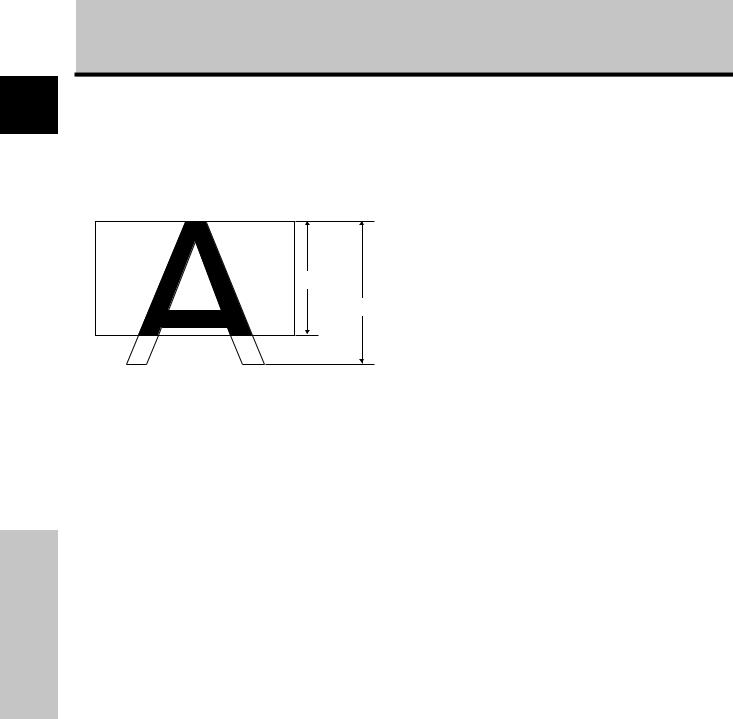
English
Operations
4 PARTIAL (*Supported only on PDP-503MXE)
The PARTIAL setting is available only during personal computer input (1280 x 1024/60 Hz only).
The input signal and the screen maintain a dot to line ratio of 1:1. Display is highly faithful to the source. However, in order to maintain the 1:1 ratio, a portion of the display will not appear on the screen.
768 lines
1024 lines
Use 5/∞ to adjust the position of the video image on the screen.
Moving the screen position upward or downward
(*Supported only on PDP-503MXE)
During personal computer input (1280 x 1024/60Hz only), even when the PARTIAL setting is selected, the position of the screen can be adjusted by using 5/∞. The adjustment value will not, however, be stored in memory.
Operations
22
En
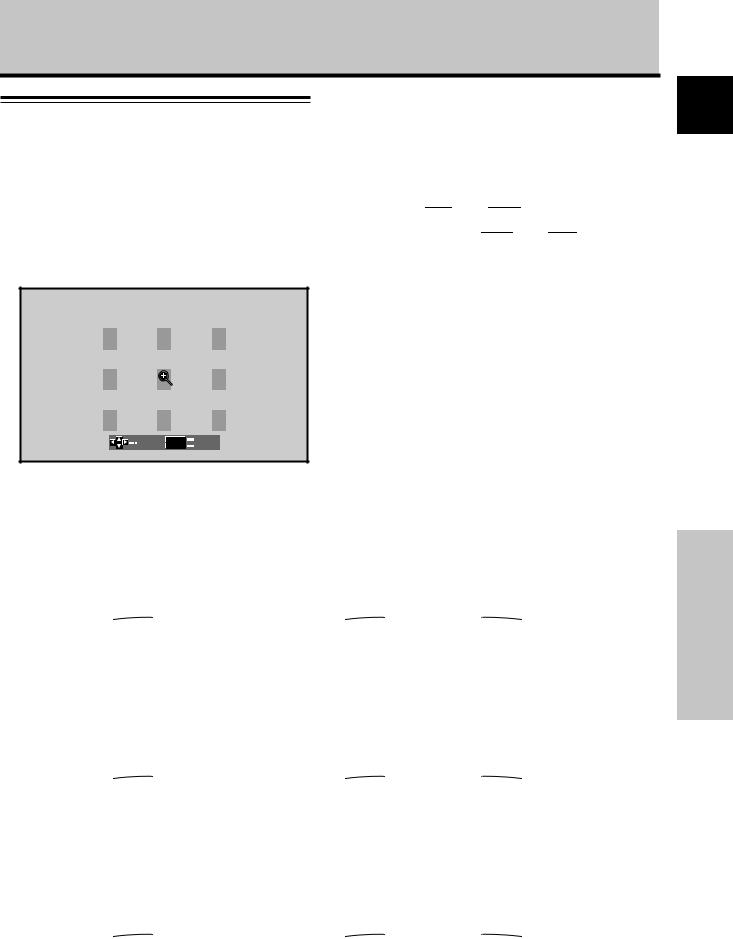
Operations
Partial Image Enlargement
(POINT ZOOM)
This display allows any one of nine screen areas (AREA 1 to AREA 9) to be selected and enlarged to x1.5, x2, x3, or x4. When performing point zoom enlargement, the direction buttons (5/∞/2/3) can be used to move the enlarged portion up-down and right-left.
1 Press the remote control unit’s POINT ZOOM.
P.ZOOM EXIT
SELECT SET ZOOM
Note
Whenever point zoom is selected, the screen size automatically changes to FULL.
2Press 5/∞/2/3 as required to select the desired screen area (AREA 1 to AREA 9).
3Press SET to select the zoom ratio.
Pressing SET repeatedly changes the zoom ratio in the following order:
|
3 x 1.5 |
|
3 x 2.0 |
|
|
|
|
|
|
||
|
x 4.0 2 |
|
x 3.0 2 |
|
|
|
|
|
|||
÷When the zoom ratio is changed, the screen image is enlarged based on the screen center.
÷5/∞/2/3 can be used to move the enlarged portion up-down and right-left.
÷If no operation is undertaken for three seconds or more, the display screen will disappear.
SET or 5/∞/2/3 can be pressed again if desired to change the zoom ratio or display position.
4Press the remote control unit’s POINT ZOOM once again to cancel the point zoom operation.
The point zoom function will also be canceled whenever the input signal changes, the menu screen is displayed, or the INPUT changes.
AREA 1 display range |
|
AREA 2 display range |
|
AREA 3 display range |
|||||||||||||||||||||||
|
|
|
|
|
|
|
|
|
|
|
|
|
|
|
|
|
|
|
|
|
|
|
|
|
|
|
|
|
|
|
|
|
|
|
|
|
|
|
|
|
|
|
|
|
|
|
|
|
|
|
|
|
|
||
|
|
|
|
|
|
|
|
|
|
|
|
|
|
|
|
|
|
|
|
|
|
|
|
|
|
|
|
|
|
|
|
AREA 1 |
|
|
|
|
|
|
|
|
|
AREA 2 |
|
|
|
|
|
|
|
|
|
AREA 3 |
|
|
|
|
|
|
|
x 4.0 |
|
|
|
x 3.0 |
|
|
|
|
|
x 4.0 |
|
|
|
x 3.0 |
|
x 3.0 |
|
|
|
x 4.0 |
|
|
|
|
|
|
|
|
|
|
|
|
|
|
|
|
|
|
|
|
|
|
|
|
|
|
|
|
|||
|
x 2.0 |
|
|
|
|
|
|
x 2.0 |
|
|
|
|
|
|
x 2.0 |
||||||||||||
|
|
|
|
x 1.5 |
|
|
|
|
|
|
|
x 1.5 |
|
|
|
|
|
|
|
x 1.5 |
|
||||||
|
|
|
|
|
|
|
|
||||||||||||||||||||
AREA 4 display range |
|
AREA 5 display range |
|
AREA 6 display range |
|||||||||||||||||||||||
|
|
|
|
|
|
|
|
|
|
|
|
|
|
|
|
|
|
|
|
|
|
|
|
|
|
|
|
|
|
|
|
|
|
|
|
|
|
|
|
|
|
|
|
|
|
|
|
|
|
|
|
|
|
|
|
|
|
|
|
|
|
|
|
|
|
|
|
|
|
|
|
|
|
|
|
|
|
|
|
|
|
|
|
|
|
|
|
|
|
|
|
|
|
|
|
|
|
|
|
|
|
|
|
|
|
|
|
|
|
|
|
|
|
|
|
|
|
|
|
|
|
|
|
|
|
|
|
|
|
|
|
|
|
|
|
|
|
|
|
|
|
|
|
AREA 4 |
|
|
|
|
|
|
|
|
|
AREA 5 |
|
|
|
|
|
|
|
|
|
AREA 6 |
|
|
|
|
|
|
|
x 4.0 |
|
|
|
x 3.0 |
|
|
|
|
|
x 4.0 |
|
|
|
x 3.0 |
|
x 3.0 |
|
|
|
x 4.0 |
|
|
|
|
|
|
|
|
|
|
|
|
|
|
|
|
|
|
|
|
|
|
|
|
|
|
|
|
|
|
|
|
x 2.0 |
|
|
|
|
|
|
x 2.0 |
|
|
|
|
|
|
x 2.0 |
||||||||||||
|
|
|
|
x 1.5 |
|
|
|
|
|
|
|
x 1.5 |
|
|
|
|
|
|
|
x 1.5 |
|
||||||
|
|
|
|
|
|
|
|
||||||||||||||||||||
AREA 7 display range |
|
AREA 8 display range |
|
AREA 9 display range |
|||||||||||||||||||||||
|
|
|
|
|
|
|
|
|
|
|
|
|
|
|
|
|
|
|
|
|
|
|
|
|
|||
|
|
|
|
|
|
|
|
|
|
|
|
|
|
|
|
|
|
|
|
|
|
|
|
|
|
|
|
|
|
|
|
|
|
|
|
|
|
|
|
|
|
|
|
|
|
|
|
|
|
|
|
|
|||
|
|
|
|
|
|
|
|
|
|
|
|
|
|
|
|
|
|
|
|
|
|
|
|
|
|
||
|
|
|
|
|
|
|
|
|
|
|
|
|
|
|
|
|
|
|
|
|
|
|
|
|
|
|
|
|
|
|
|
AREA 7 |
|
|
|
|
|
|
|
|
|
AREA 8 |
|
|
|
|
|
|
|
|
|
AREA 9 |
|
|
|
|
|
|
|
x 4.0 |
|
|
|
x 3.0 |
|
|
|
|
|
x 4.0 |
|
|
|
x 3.0 |
|
x 3.0 |
|
|
|
x 4.0 |
|
|
|
|
|
|
|
|
|
|
|
|
|
|
|
|
|
|
|
|
|
|
|
|
|
|
|
|
|||
|
x 2.0 |
|
|
|
|
|
|
x 2.0 |
|
|
|
|
|
|
x 2.0 |
||||||||||||
|
|
|
|
x 1.5 |
|
|
|
|
|
|
|
x 1.5 |
|
|
|
|
|
|
|
x 1.5 |
|
||||||
23
English
Operations
En
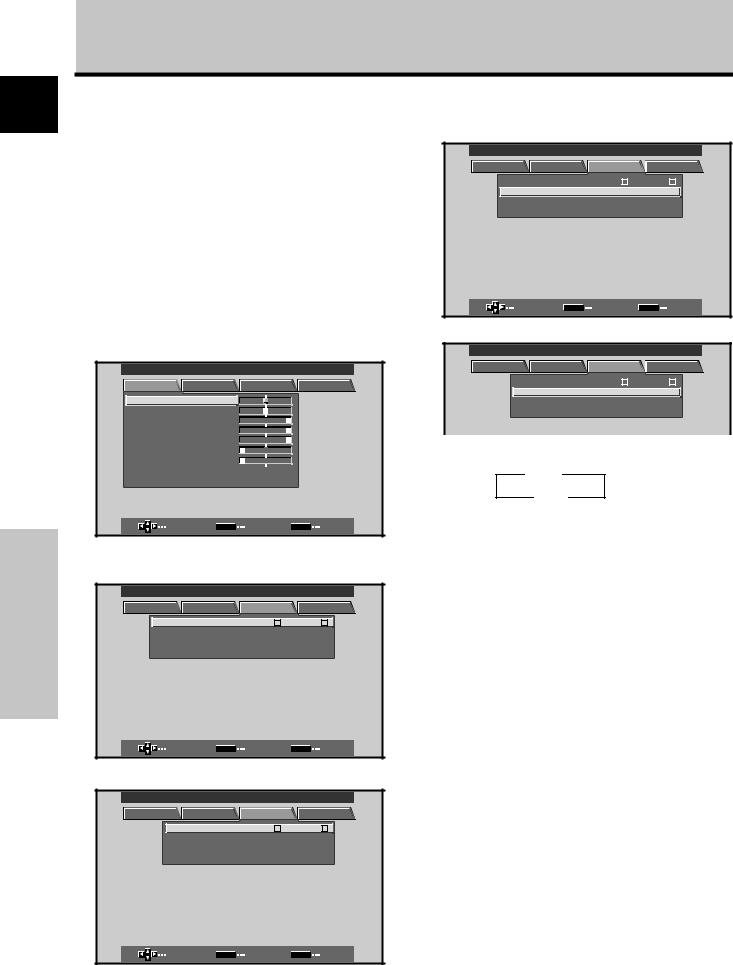
English
Operations
Operations
|
3 Press 5/∞ to select either the POWER |
|
|
||
Automatic Power OFF |
||
MANAGEMENT or AUTO POWER OFF mode. |
This display is equipped with automatic powermanagement and auto-power-off functions, which allow the unit to automatically switch to power-saving mode when no sync signal is detected.
(A warning message appears onscreen before these functions operate.)
Notes
÷The Power Management function can be set only when the INPUT 1 signal is selected.
÷The automatic power-off function can be set only when the INPUT 2 signal is selected.
÷Always turn off the plasma display’s main power switch when not using the display for extended periods of time.
[When using INPUT 1]
MAIN |
MENU |
|
|
|
|
|
INPUT1 |
PICTURE |
SCREEN |
SET UP |
OPTION |
||||
|
I NP UT L A B E L |
|
: I NP UT 1 |
||||
|
POWE R |
MA NA GEME NT : OF F |
|
||||
|
C L AMP |
P O S I T I O N |
: A U T O |
|
|||
|
S E T T I N G |
|
: V G A |
|
|||
|
SELECT |
SET |
CHANGE |
MENU |
EXIT |
||
[When using INPUT 2]
1 Press MENU to display the menu screen. |
MAIN MENU |
|
|
INPUT2 |
||||||||
MAIN MENU |
|
|
|
|
|
|
INPUT1 |
PICTURE |
SCREEN |
SET UP |
OPTION |
|
|
|
|
|
|
|
|
|
|
|
|
||
PICTURE |
SCREEN |
SET UP |
OPTION |
|
I NP UT L A B E L |
: I NP UT 2 |
||||||
|
A UTO |
P OWE R |
OF F : OF F |
|
||||||||
|
|
: |
|
|
|
|
|
|
|
|||
CO NT RA S T |
|
0 |
|
|
|
|
|
C L AMP |
P O S I T I O N : A U T O |
|
||
BR I GHT . |
|
: |
0 |
|
|
|
|
|
S E T T I N G |
: V G A |
|
|
R. L E V E L |
|
: + 6 0 |
|
|
|
|
|
|
|
|
|
|
G. L E V E L |
|
: + 6 0 |
|
|
|
|
|
|
|
|
|
|
B. L E V E L |
|
: + 6 0 |
|
|
|
|
4 Press SET to confirm selection of the POWER |
|||||
H. E NHAN CE |
: |
0 |
|
|
|
|
||||||
V . E NHAN CE |
: |
0 |
|
|
|
|
MANAGEMENT or AUTO POWER OFF. |
|||||
RE S E T |
|
|
|
|
|
|
|
|
3 OFF |
|
|
|
|
|
|
|
|
|
|
|
|
|
|
|
|
|
|
|
|
|
|
|
|
|
ON 2 |
|
|
|
|
|
|
|
|
|
|
|
÷ When OFF is selected, the display will continue in |
||||
SELECT |
|
SET |
ENTER |
|
MENU |
EXIT |
operating mode, regardless of the presence/ |
|||||
|
|
|
|
|
|
|
|
|||||
2 Press 2/3 to select SET UP. |
|
|
|
absence of an input sync signal. |
|
|||||||
|
|
|
÷ When POWER MANAGEMENT: ON is selected, if |
|||||||||
[When using INPUT 1] |
|
|
|
|
a sync signal is not detected, a warning message is |
|||||||
MAIN MENU |
|
|
|
|
|
|
INPUT1 |
displayed for 8 seconds, after which the display |
||||
PICTURE |
SCREEN |
SET UP |
OPTION |
automatically enters the power-saving mode (*1) |
||||||||
I NP UT |
L A B E L |
|
: |
I NP UT 1 |
and the STANDBY/ON indicator flashes green. If a |
|||||||
POWE R |
MA NAGEME NT : OF F |
|
sync signal (*2) is input again later, the plasma |
|||||||||
C L AMP |
P O S I T I O N |
: A U T O |
|
|||||||||
S E T T I N G |
|
|
: V G A |
|
display automatically returns to normal operating |
|||||||
|
|
|
|
|
|
|
|
|||||
|
|
|
|
|
|
|
|
mode. |
|
|
|
|
|
|
|
|
|
|
|
|
*1. Power consumption about 1W |
|
|||
|
|
|
|
|
|
|
|
*2. Except when input signal is SYNC on G or composite |
||||
|
|
|
|
|
|
|
|
SYNC |
|
|
|
|
|
|
|
|
|
|
|
|
÷ When AUTO POWER OFF: ON is selected and if no |
||||
SELECT |
|
SET |
ENTER |
|
MENU |
EXIT |
sync signal is detected for 8 minutes or more, a |
|||||
|
|
|
|
|
|
|
||||||
|
|
|
|
|
|
|
|
warning message will be displayed for 30 seconds |
||||
[When using INPUT 2] |
|
|
|
|
after which the unit's power will switch to |
|||||||
MAIN MENU |
|
|
|
|
|
|
INPUT2 |
STANDBY mode. |
|
|
|
|
PICTURE |
SCREEN |
SET UP |
OPTION |
5 When the setup is finished, press MENU to exit |
||||||||
I NP UT L A B E L |
|
: I NP UT 2 |
||||||||||
|
the menu screen. |
|
|
|
||||||||
A UTO P OWE R |
O F F : O F F |
|
|
|
|
|||||||
C L AMP |
P O S I T I O N : A U T O |
|
Note |
|
|
|
|
|||||
S E T T I N G |
|
: V G A |
|
The POWER MANAGEMENT and AUTO POWER OFF functions |
||||||||
|
|
|
|
|
|
|
|
|||||
|
|
|
|
|
|
|
|
must be set individually for each input (INPUT 1 or INPUT 2). |
||||
|
|
|
|
|
|
|
|
To return to operating mode: |
|
|||
|
|
|
|
|
|
|
|
÷ To return to normal operation from POWER |
||||
|
|
|
|
|
|
|
|
MANAGEMENT mode: either operate the computer, |
||||
SELECT |
|
SET |
ENTER |
|
MENU |
EXIT |
or press INPUT on the Main Unit Operating Panel or |
|||||
|
|
remote control unit. |
|
|
|
|||||||
|
|
|
|
|
|
|
|
|
|
|
||
|
|
|
|
|
|
|
|
÷ To return to normal operation from AUTO POWER |
||||
|
|
|
|
|
|
|
|
OFF mode: Press STANDBY/ON on the Main Unit |
||||
24 |
Operating Panel or remote control unit. |
En
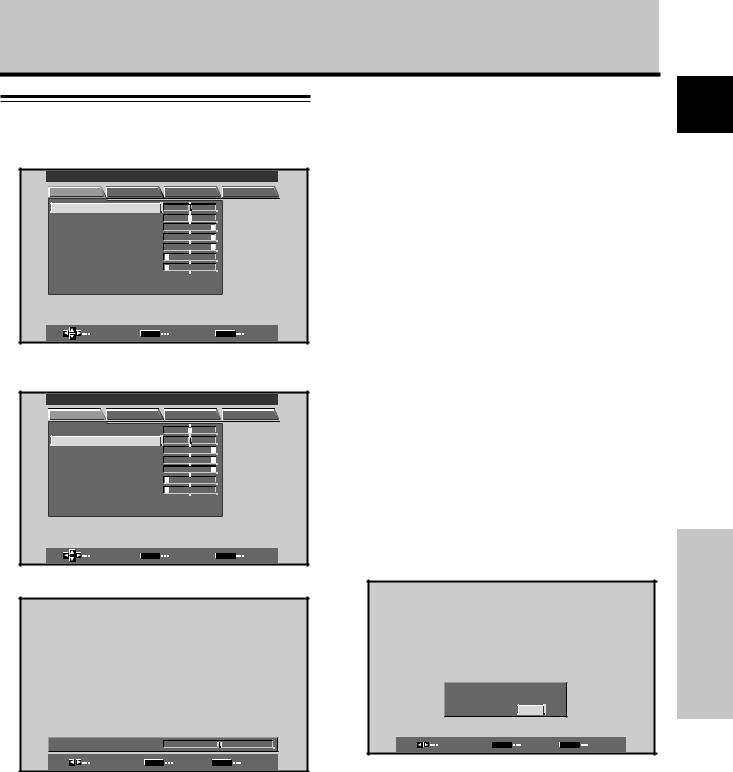
Display Panel Adjustments
Adjusting the Picture Quality
1 Press MENU to display the menu screen.
MAIN MENU |
|
|
|
|
|
INPUT1 |
PICTURE |
SCREEN |
SET UP |
OPTION |
|||
CO NT RA S T |
|
: |
0 |
|
|
|
BR I GHT . |
|
: |
0 |
|
|
|
R. L E V E L |
|
: + 6 0 |
|
|
|
|
G. L E V E L |
|
: + 6 0 |
|
|
|
|
B. L E V E L |
|
: + 6 0 |
|
|
|
|
H. E NHAN CE |
: |
0 |
|
|
|
|
V . E NHAN CE |
: |
0 |
|
|
|
|
RE S E T |
|
|
|
|
|
|
SELECT |
|
SET |
ENTER |
MENU |
EXIT |
|
2Press 5/∞ to select the adjustment item, then press SET.
MAIN MENU |
|
|
|
|
|
INPUT1 |
PICTURE |
SCREEN |
SET UP |
OPTION |
|||
CO NT RAS T |
|
: |
0 |
|
|
|
B R I GHT . |
|
: |
0 |
|
|
|
R. L E V E L |
|
: + 6 0 |
|
|
|
|
G. L E V E L |
|
: + 6 0 |
|
|
|
|
B. L E V E L |
|
: + 6 0 |
|
|
|
|
H. E NHAN CE |
: |
0 |
|
|
|
|
V . E NHAN CE |
: |
0 |
|
|
|
|
RE S E T |
|
|
|
|
|
|
SELECT |
|
SET |
ENTER |
MENU |
EXIT |
|
PICTURE mode adjustment items
Below are brief descriptions of the options that can be set in the PICTURE mode.
CONTRAST ············· Adjust according to the surrounding brightness so that the picture can be seen clearly.
BRIGHT. ·················· Adjust so that the dark parts of the picture can be seen clearly.
R. LEVEL ················· Adjust the amount of red in the picture.
G. LEVEL ················· Adjust the amount of green in the picture.
B. LEVEL ················· Adjust the amount of blue in the picture.
H. ENHANCE··········· Sharpens the image in the horizontal direction.
V. ENHANCE ··········· Sharpens the image in the vertical direction.
To reset PICTURE mode settings to the default
If settings have been adjusted excessively or the picture on the screen no longer appears natural, it may prove more beneficial to reset the PICTURE mode to default settings instead of trying to make adjustments under already adjusted conditions.
1In step 2 in the previous procedure, press 5/∞ to select RESET, then press SET.
3 Press 2/3 to adjust the picture quality as desired.
|
|
|
|
|
|
P I C T U RE R E SE T ? |
|
||
|
|
|
|
|
|
Y E S |
|
N O |
|
|
BR I GH T . |
: |
0 |
|
|
SELECT |
SET |
SET |
MENU EXIT |
|
ADJUST |
|
SET |
SET |
MENU EXIT |
2 Press 2/3 to select YES, and press SET. |
|||
4 |
|
|
|
|
|
||||
Press SET. |
|
|
|
|
All PICTURE mode settings are returned to the factory |
||||
|
Pressing SET writes the value into the memory and |
set default. |
|
|
|
||||
returns the display to the step 2 screen.
5When the setup is finished, press MENU to exit the menu screen.
Note
Make these adjustments for each input (INPUT1 to INPUT2) and signals.
English
Display Panel Adjustments
25
En

English
Display Panel Adjustments
Display Panel Adjustments
Adjusting the Image Position and
Clock (Automatic Adjustment)
Pressing AUTO SET UP on either the display or the remote control unit will adjust the screen position and clock to optimum values.
Note
Perform this adjustment individually for each input function (INPUT 1, INPUT 2), and each signal type.


 AUTO
AUTO
SET UP
AUTO SET UP
Main Unit Operating Panel |
Remote Control Unit |
Press AUTO SET UP on either the main unit or remote control unit.
÷Optimum settings may not be possible for lowluminance and certain other kinds of signals. In this case, follow the instructions in the section “Manual Adjustment of Screen Position and Clock” to make more precise adjustments.
26
En
